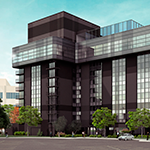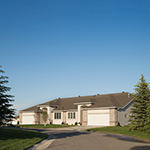By 2003, Bonner Carrington had already successfully developed its first senior community, and it was interested in diving further into the market. The firm partnered again with the developer it had worked with on the first community—but right away, Stuart Shaw, founder and president of Bonner Carrington, felt something was off.
“I realized it wasn’t doing as well as I thought, so I asked myself why,” he says. “As it turned out, there were weaknesses in the concept, design, and amenities, such that the community didn’t adequately meet the needs of the senior market.” In the middle of his work on the project (branded Mariposa, which means “butterfly” in Spanish), Shaw decided to take a new approach. It was a decision that upset his lenders and investors.
“I suddenly called ‘time-out’ and spent about an extra $1 million creating a new design with a sense of place; in doing so, we created something we love,” he says. The decision wound up paying off, and Shaw has since built a series of additional Mariposa communities. Here’s a look at their success and Shaw’s experience by the numbers.
$1 billion
Shaw is a veteran entrepreneur. He started Bonner Carrington in 1988 after having worked in the real estate business as a broker since 1980. By the late 1990s, the company—in cooperation with its partners—was the third-largest landowner in downtown Austin, behind only the State of Texas and the City of Austin. Bonner Carrington used much of its real estate—several city blocks—to develop an urban mixed-use community that validated the Austin Warehouse District, and today the value of the district’s properties is estimated to exceed $1 billion.
2000
After developing downtown Austin with partners, Shaw wanted to do a project on his own. It was 2000, and Bonner Carrington controlled a large tract of land outside the city. Shaw decided to develop it into two multifamily communities, one of which the company wanted to do on its own. The result—
a 236-unit general-population community called Cypress Creek Apartment Homes, in Cedar Park, Texas—proved to Shaw that he understood the requirements of apartment communities, and it set the stage for his entrance into senior housing.
10K retirees a day
On January 1, 2011, the oldest members of the baby boom generation—who crowded public schools in the 1950s and entered the labor force in the 1970s—celebrated their 65th birthday. Every day since, 10,000 more baby boomers have reached the age of 65, and that pace will continue until the year 2029. Ultimately, they’ll all need housing, which is exactly what Shaw realized and what led him to launch the first Mariposa community.
180 units
By 2003, Bonner Carrington’s first senior community was doing well—not so much in terms of monetary success but in terms of leasing, with all 180 units occupied. That, Shaw says, is where the story gets interesting. “My partners in our first senior community came from a nursing-home background, and I was coming from an apartment-home background, so I decided to do things differently with my next project,” he says.
4 buildings
Many senior communities use an H-shaped or X-shaped design that is institutional looking, and “the last thing you want to do when building for seniors is create something institutional,” Shaw says. His goal was to create a sense of place. “People visit Paris and New York, and they come back talking about that emotional experience,” he says. “I wanted to recreate that experience.”
The Mariposa Apartment Homes development in San Marcos, for example, uses a centuries-old courtyard design, with four 30- to 60-unit buildings placed around a courtyard so that all units, which have balconies or patios, have a view of either the courtyard or the landscape surrounding the complex. The colorful Spanish mission-style exterior also serves the Spanish culture of the area well. “It was just beautiful and has been a runaway success to this day,” Shaw says.
6 communities
Today, Bonner Carrington operates six Mariposa communities across Texas: in Georgetown, Houston, Amarillo, North Houston, League City/Dickinson, and San Marcos. All have similar amenities that contribute to their “sense of place,” including activity rooms, commercial kitchens, coffee rooms, parlors, libraries, beauty and barber salons, fitness centers, and business centers populated with Apple computers. Some locations even have theaters with 100-inch screens and popcorn machines. And, outside, residents can typically find pools, Weber Performa grills, rose gardens, raised garden beds for resident use, boule and shuffleboard courts, pet parks, and outdoor gathering areas.


